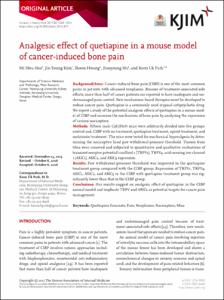Analgesic effect of quetiapine in a mouse model of cancer-induced bone pain
- Keimyung Author(s)
- Ha, Eun Young; Park, Keon Uk; Kim, Jin Young; Hwang, Il Seon; Heo, Mi Hwa
- Journal Title
- Korean Journal of Internal Medicine
- Issued Date
- 2017
- Volume
- 32
- Issue
- 6
- Keyword
- Mice; Neoplasms; Nociceptors; Pain; Quetiapine fumarate
- Abstract
- BACKGROUND/AIMS:
Cancer-induced bone pain (CIBP) is one of the most common pains in patients with advanced neoplasms. Because of treatment-associated side effects, more than half of cancer patients are reported to have inadequate and undermanaged pain control. New mechanism-based therapies must be developed to reduce cancer pain. Quetiapine is a commonly used atypical antipsychotic drug. We report a study of the potential analgesic effects of quetiapine in a mouse model of CIBP and examine the mechanism of bone pain by analyzing the expression of various nociceptors.
METHODS:
Fifteen male C3H/HeN mice were arbitrarily divided into five groups: control and, CIBP with no treatment, quetiapine treatment, opioid treatment, and melatonin treatment. The mice were tested for mechanical hyperalgesia by determining the nociceptive hind paw withdrawal pressure threshold. Tissues from tibia were removed and subjected to quantitative and qualitative evaluations of transient receptor potential vanilloid 1 (TRPV1), TRPV4, acid-sensing ion channel 1 (ASIC1), ASIC2, and ASIC3 expression.
RESULTS:
Paw withdrawal pressure threshold was improved in the quetiapine treatment group compared with the CIBP group. Expression of TRPV1, TRPV4, ASIC1, ASIC2, and ASIC3 in the CIBP with quetiapine treatment group was significantly lower than that in the CIBP group.
CONCLUSIONS:
Our results suggest an analgesic effect of quetiapine in the CIBP animal model and implicate TRPV and ASICs as potential targets for cancer pain management.
- Publisher
- School of Medicine (의과대학)
- Citation
- Mi Hwa Heo et al. (2017). Analgesic effect of quetiapine in a mouse model of cancer-induced bone pain. Korean Journal of Internal Medicine, 32(6), 1069–1074. doi: 10.3904/kjim.2015.377
- Type
- Article
- ISSN
- 1226-3303
- 파일 목록
-
-
Download
 oak-2018-0099.pdf
기타 데이터 / 1.21 MB / Adobe PDF
oak-2018-0099.pdf
기타 데이터 / 1.21 MB / Adobe PDF
-
Items in Repository are protected by copyright, with all rights reserved, unless otherwise indicated.